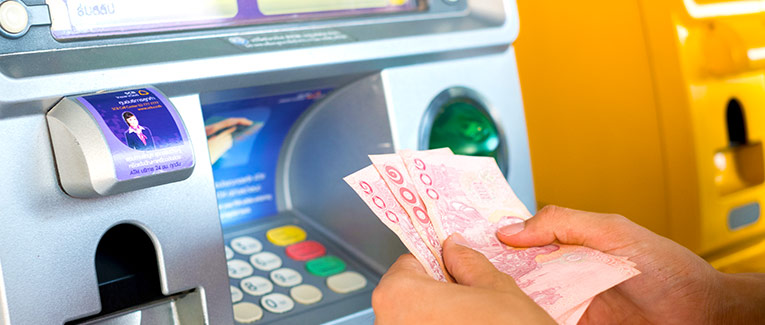
10 out of every 100 people fell victim to ATM scams in 2019 – while only four in 100 people had their credit cards physically stolen. What does this mean? Fraudsters can extract money from your bank account without needing your physical credit or debit card at all.
Countries like the U.S. are installing EMV chip scanners into ATMs to prevent scams, but you cannot always bank on such anti-theft technology when traveling abroad.
Preparedness follows awareness. So, first you must learn about the most common ATM scams.
1. See Tape, Glue or Scratches? Recognize Card Skimming
Card skimming is the most rampant ATM scam across the world. Card skimming occurs when a magnetic strip is attached to the card slot. This strip captures essential information like your PIN and card number. Then, the scammer receives the information and can access your bank account by using said information.
It is hard to spot, but not impossible. With a little extra vigilance, you can recognize card skimming. Carefully examine the card slot and keypad for:
- Bulkiness
- Signs of repair
- Tape
- Glue
- Scratches or cracks
- Counterfeit keypad covering the original
If you discover any of the above, it means that the ATM has been compromised. Do not insert your card into the machine. If the keypad is loose or spongy, it has most likely been tampered with. Call the respective bank to alert them about the scam.
2. Don’t Fall for Card Traps
What can you do when your card gets stuck in an ATM? After a point, you might walk away, promising yourself to pay a visit to the bank the first thing the next day. However, your card may not be stuck inside by accident.
Fraudsters install a device the in ATMs that creates a barrier when the card is being ejected after the transaction and pushes it back into the machine. The owner ends up believing that the card has been retained.
The card will probably already be skimmed, therefore providing the scammer with all of the information needed to withdraw cash from your account. However, the fraudster may appear and innocently attempt to help you. Don’t fall for it, as they’re only waiting to see you enter your PIN again.
If you find yourself in this situation, do not trust anyone who attempts to help. Shield the keypad with your hand to prevent anyone from learning your pin, and if your card is stuck, do not walk away. Call your bank immediately and wait until they block your card.
3. Spot Hidden Cameras by Doing This
Installing hidden cameras to capture the PIN, and later stealing the credit card, is the oldest trick in the book. However, merely shielding the keypad with your hand may not be enough.
Professional ATM fraudsters install compact cameras in ATMs so that they are invisible to the naked eye. But, your smartphone can spot them.
Using your phone’s flashlight is an excellent method to spot hidden cameras, however this technique only works in the dark. You can simply install a camera detector app on your iPhone or Android smartphone. The detector will display a red glow to mark the space where the camera is.
4. Beware of “Shoulder Surfers”
Not all ATM fraudsters are tech-savvy. Some of them might linger behind you while you complete your transaction so that they can see your PIN. Then, their accomplice will distract you, and your card will vanish.
Prevent this from happening by doing the following:
- Visit high-traffic ATMs
- Visit ATMs inside banks
- Do not let anyone help you with your transaction.
- Be vigilant about your card – do not let it out of your sight
5. Avoid Isolated ATMs – Crowded Means Safer
An ATM next to the grocery store is safer than the isolated one down the street. ATMs that are in public settings and are visited more often are less likely to be tampered with.
Scammers usually target ATMs that aren’t under any supervision, or are shielded from public view. Credit card theft is also more likely in such areas.
6. Outsmart The Scammers – Use Credit Cards Over Debit Cards
Using a credit card is essentially borrowing money from the bank and repaying it later. The gap between the expenditure and the repayment allows for safety nets against fraudulent expenditure.
Credit cards under the Fair Credit Billing Act in the U.S. limit the liability for unauthorized charges at $50. So, if you report the loss of your credit card prior to it being used by the thief, the issuer cannot hold you liable for more than $50.
Most banks across the world offer similar protection for credit cards. In a lot of countries, zero-liability protection is offered against fraudulent expenditure, where the card owner owes the bank nothing. Using your credit card while traveling provides certain protection for your money.
In comparison, there is less protection for debit cards.
7. Use Your Smartphone to Make Payments
56% of retailers accept mobile payments. Google Pay, Apple Pay, PayPal and Samsung Pay are some of the most popular mobile payment apps.
Before you leave for your trip abroad, go over your itinerary to see how much cash you’ll require. Carry the bare minimum, and use mobile payments over cash payments. Along with being more sanitary, it reduces the need to withdraw cash, and prevents you from getting scammed.
If you’re in desperate need of cash and no ATM near you seems safe, you can contact your travel insurance provider. If you have a good travel insurance provider, you can enjoy perks like emergency cash services.
8. Keep Close Tabs on Your Bank Account
Fraud is a possibility no matter how careful you may be. Check your bank activity at least twice a week, if not daily when traveling. If you report the fraudulent activity in time, it may save your money.

